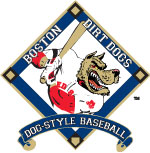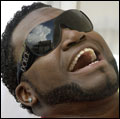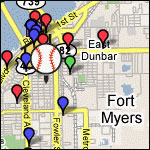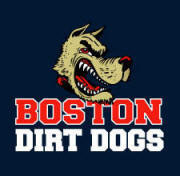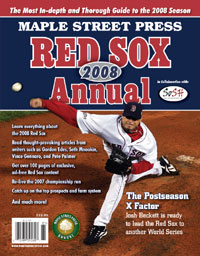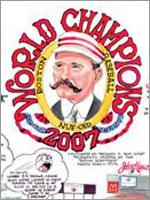It's Not a League of Their Own
|
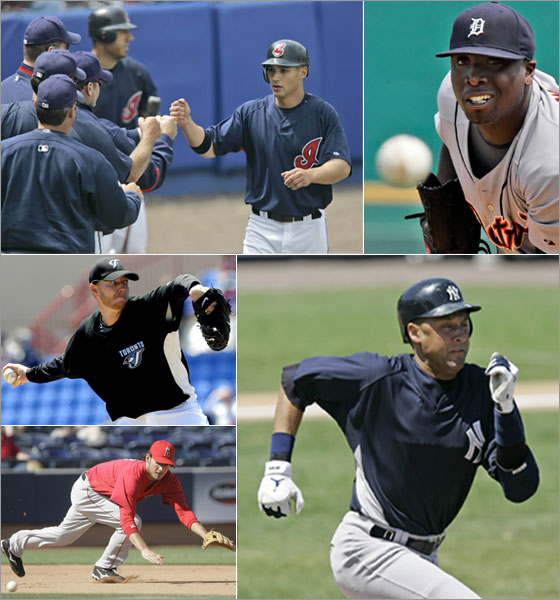
|
|
(Wire Photos) |
The Sox Face Some Stiff Competition in Their Quest to Repeat
BDD's exclusive excerpt of the Maple Street Press 2008 Red Sox Annual
Sizing up the Competition: A Look Around the 2008 American League, by Jeff Kuhn
For the second time in four years, the Boston Red Sox are World Series champions. Like 2004, the Sox won while sweeping the Angels in the AL Divisional Series, coming back from the brink of elimination in the AL Championship Series to win the pennant, and then sweeping a National League opponent. Unlike 2004, however, this Red Sox team led the AL East essentially wire to wire during the regular season and tied for the best record in baseball. For the first time since 1915, the Red Sox can boast that they thoroughly vanquished the league.
In 2008, the AL is still violently divided between the haves and the have-nots, with only the previous playoff teams and the Tigers serious contenders for the 2008 World Series from the Junior Circuit. Most of the separation is centered around the dearth of talent moving this past offseason, with only the Miguel Cabrera/Dontrelle Willis trade in, and the Johan Santana Oakland trades out even causing a blip serious enough to overthrow the balance of power. The story of 2008 in the second tier of the league will be how these teams build from within, to prime themselves to take the reins from the current Red Sox/Yankees/Angels triumvirate that have dominated the league over the last six years. The Indians and Tigers have elbowed into the ALís elite class, but eventually the current power will be old and grey. The spoils will go to those who aggressively improve over the next few seasons, starting with the ALís 107th season.
A LOOK AT THE SOX COMPETITION IN THE AL EAST
BALTIMORE ORIOLES
"Don't matter how many times you get burnt, you just keep doin' the same." Ė Preston ďBodieĒ Broadus
With the Ravens finishing their latest campaign with five wins, and coachless, no NBA or NHL team to speak of, and the Orioles starting their second decade of irrelevancy, Baltimoreís only real contribution to the entertainment realm is The Wire, HBOís critically-acclaimed police drama that focuses on institutional dysfunction. In The Wire, a broken system actually prefers to stay broken than to work to fix itself. Charm City looks extremely bleak through this lens.
This dovetails nicely with the state of Baltimoreís baseball franchise. Since the Oís had their run of divisional success after the advent of the wild card, the Orioles have shown no ability to dig themselves out of the hole created by being a member of the American League East. The Orioles have been unable to execute a rebuilding plan over the last decade, and after a year where their major accomplishment was keeping the Rays in last place, the best that can be said for this dilapidated franchise is that it canít get much worse.
The only problem with that is the bottom is still to come. New honcho Andy MacPhail traded the declining Miguel Tejada and Erik Bedard and is actively shopping Brian Roberts, which leaves Nick Markakis to carry the offense. There is a plan in place, however, with MacPhail signing the Oriolesí first two Scott Boras-represented draftees in the Peter Angelos era, by throwing cash at Matt Weiters and Jake Arrieta. Troy Patton was nice haul for Miguel Tejada too. MacPhail is tearing down the core of the Orioles with an eye towards 2010, and it makes it look like itís morning in Baltimore. It has just been too long since the new boss has been different from the old.
NEW YORK YANKEES
After the Yankees bowed out to Cleveland in the playoffs last year the Bombers had what one can only describe as a ďcrisis of confidence.Ē Gone was George Steinbrenner, stepping aside for his sons, with Hank Steinbrenner overseeing the day-to-day operations of the team, and Joe Torre for Joe Girardi, which means the on-field team is under new stewardship for the first time since 1995. There were drawn-out negotiations with Alex Rodriguez and Mariano Rivera, including Hank doing a good impression of his fatherís feisty period by doing his best to make A-Rod cry during the negotiation process.
For all the hysterics that followed the Yankees around this offseason, they didnít improve the team very much on the field, which puts a huge burden on young players like Melky Cabrera, Robinson Cano, Philip Hughes, and Joba Chamberlain to keep the Yankees a playoff-caliber team. Which is why they made overtures to the Twins for Johan Santana, since the Yankees pitching wasnít at all that consistent last year. Brian Cashman did a good job of staying the course and not overpaying for Santana by just blowing any rumored Red Sox proposals out of the water and sending Cabrera, Hughes, Ian Kennedy and Jeff Marquez over to the Twin Cities. The Yankees need pitching badly enough that there was pressure (internal or external) to overpay for Santana, but Cashman stood his ground. Likewise, in an effort to save Chamberlainís arm, the pre-season signs are pointing to a return to the bullpen for Joba, though he would probably have more value to the Yankees in the rotation, where Chein-Ming Wang leads a crew of pitchers, who are either in the death throes of their careers (Andy Pettitte and Mike Mussina) or in their beginning (Philip Hughes).
For the first time since Bill Clinton was impeached, the Yankees are going into a season without the AL East banner, and theyíve been denied entry into the ALCS every year since 2004. The two biggest weaknesses in 2008 are age and rotation quality, and the only way to fight one is to sacrifice the other. Cashman has seemingly chosen youth, which is more risky, but will have the higher reward. It just wonít come in 2008.
TAMPA BAY RAYS
My economics are rusty, but when you have an inferior product in a saturated, inelastic market, one strategy is to re-brand the product. Therefore, exit the Devil, and their aqua uniforms, to be replaced by the San Diego Padres kits with blue replacing sand brown.
The ironic thing is that the newly-branded Tampa Bay Rays are no longer an inferior product. The players they have are developing quite nicely and the farm system is still ripening some pretty tasty fruits, with top prospect Evan Longoria taking a break from Desperate Housewives to take over third base, joining a team already featuring under-27ers Dioner Navarro, Carl Crawford, B.J. Upton, Rocco Baldelli, Scott Kazmir, Edwin Jackson, Jason Shields, and Matt Garza, among others. Garza, in fact, came over in General Manager Andrew Friedmanís shrewdest trade, dealing Delmon Young from the outfield surplus and Brendan Harris to Minnesota for the young hurler and projected starting shortstop Jason Bartlett. This never would have happened under Chuck LaMar, who preferred to stand pat rather than improve the team.
Friedman actually even went ahead and found some capable vets to fill the roster and buy the kids their beer. Cliff Floyd can cover the inevitable Rocco Baldelli injury, and Willy Aybar is a nice backup in case anyone in the infield gets hurt. They even extended Carlos Pena for three years, which might be the first time an effective, young (heís the gray beard in the starting lineup at 30) player decided to stay with the Rays.
St. Peteís isnít desolate anymore. Though the Rays arenít quite competitors yet (or even good), they are most certainly taking the right steps towards creating a credible franchise. Now all they need is fans to pay attention.
TORONTO BLUE JAYS
Now entering the seventh year of the J.P. Ricciardi Save Our Team Reclamation Project, the Jays are at an interesting crossroads. When Ricciardi took over the reigns of the Jays, they had four straight third-place finishes, averaging almost 84 wins a year. Since then, he has navigated Good Ship Blue Jay to five third-place finishes and has the indignity of being the only team ever to finish lower in the standings than the Tampa Bay Devil Rays. Throwing out that last place finish in 2004, the Jays have averaged 83 wins a year. So despite the free pass Ricciardi gets vis-ŗ-vis the ďnumbers GMsĒ, the Toronto squad has at best run in place during his regime, and at worst, wasted a lot of Rogers Communications money.
This trend continued this offseason, with the bizarre Troy Glaus-for-Scott Rolen trade. Without considering injuries, the Jays effectively traded their second or third best hitter to the Cardinals for Scott Rolen, who is a year older, and has hit 35 home runs over the last three seasons combined. Rolen is also due $37 million over the next three seasons (with the Cards picking up $4 million of that in 2010), while Glausís obligation is $12.75 million for one more year, which can turn into $24 million over two if Glaus picks up his player option. ďNo matterĒ, Ricciardi seemingly said, ďIíll throw in $1.8 million with Glaus!Ē
Even if you stipulate that Glaus is an injury risk, due to the nerve problem in his foot and the alleged steroid issue, the chances are that Rolen being on artificial turf can only hurt a back that has kept him out of the lineup quite frequently the last few seasons. This is not the Scott Rolen of 2002, which is something that Blue Jays fans will learn quickly.
The Blue Jays were a team starving for offense last year in the bat-rich American League. Ricciardi then traded Glaus for Rolen, and signed light-hitting shortstop David Eckstein. Thatís a lot to wager on the continued development of Alex Rios and a prayer that Vernon Wells somehow justifies the $126 million that Ricciardi gave him.
AL CENTRAL
CHICAGO WHITE SOX
When the White Sox were in the process of winning the World Series, commentators heaped praise on Kenny Williamsís master plan and Ozzie Guillenís execution of SmartBall. A new world order was on the horizon, where new-fangled analysis based on getting on base and running conservatively was eschewed for the time-honored baseball tradition of doing things the John McGraw way, without those pesky walks.
However, the 2005 White Sox won because they hit 200 home runs, covering for Ozzieís celebration of offensive deficiency, while leading the American League in run prevention. Just two years later, they stopped preventing the other team from scoring and fell to fourth place. SmartBall indeed.
For the upcoming season, the White Sox decided that John Garlandís 200 innings of above-averageness and the balance of their minor league system (when in doubt, trade Gio Gonzalez) was worth giving up to slightly upgrade. They picked up Orlando Cabrera from the Angels to help a bit with the run-prevention and bunting stuff that Ozzie loves in exchange for Garland. The kids went over to Billy Beaneís Aís for Nick Swisher, who canít be hidden on the field considering Kaptain Konerko is at first and Jim Thomeís iron glove is relegated to the bench. The obstacle is Ozzie though, as he would likely push Swisher to the bottom third of the lineup to save himself from watching Swisher strike out in the same inning as Thome.
Swisher is the litmus test for the White Sox rebuilding effort. Williams emptied the farm to get him, and he extended Guillen to use him correctly. If they donít rebound in the AL Central and become competitive quickly, the SmartMoney will have both Williams and Guillen watching the White Sox play from a sports bar by 2009.
CLEVELAND INDIANS
The holders of the AL Central crown have decided the best plan for repeating is to stand pat, riding the continued development of Mark Shapiroís nascent Empire on the Cuyahoga, with the only major waves made this offseason being overtures to the Pirates to bring in Jason Bay.
In 2007, the Indians tasted some good developmental fruits from their organizational tree. Fausto Carmona became one of the 10 best starters in the American League, and Franklyn Gutierrez showed why the Indians felt him worth Milton Bradleyís crazy self. Grady Sizemore is a star, and Jhonny Peralta rebounded very nicely after a tough sophomore year. Even Asdrubal Cabrera and Ryan Garko stepped in from the Cleveland system to make some pretty important contributions to the team that tied the Red Sox for the best record in baseball.
Unfortunately, before the Clevelanders make a run at the reigning AL Romans, they have more obstacles than any division winner in the AL. First, they have to deal with the Detroit Tigers, no small enemy. Then, they have internal questions centering around the pitching staff. Paul Byrd and Jake Westbrook have to solidify the rotation if the Indians are going to make some noise come playoff time. The bullpen has to continue to be like last yearís decent crew, which means breaking the bi-annual schizophrenic show theyíve suffered this decade of being good then bad. Iím looking at you, Bob Wickman (Joe Borowski)! Finally, in case there is some drop off from their youngs (young players are not really known for their consistency), Travis Hafner must go back to his ball-mashing self, rather than being merely scary.
Things are sunny in Cleveland for the first time since John Hart was the GM; they are good enough to walk into the playoffs, no matter what the Tigers say.
DETROIT TIGERS
The Tigers made the biggest splash of the offseason in an attempt to unseat the Indians at the top of the Central by trading top prospects Andrew Miller and Cameron Maybin (among others) to Florida for Miguel Cabreraís prodigious, Manny-Ramirez-like bat, and Dontrelle Willis. They also acquired Edgar Renteria from the Braves and Jacque Jones from the Cubs in an effort to solidify the ALís second ranked offense. In effect, Cabrera and Renteria replace Brandon Inge and Sean Casey, with incumbent shortstop Carlos Guillen moving to first base, and Jones sharing time with Marcus Thames in left.
From a talent standpoint, the Tigers look stronger than last year, especially since Casey is nearing the end and Ingeís only offensive talent is hitting home runs. The problem? The Tigers last year were none-too-good at preventing their opposition from touching the old hexagon. Detroit ranked ninth in runs allowed in the AL while playing in the same division as the ALís bottom three run scoring squads (Kansas City, Minnesota, and Chicago). Dontrelle Willis can probably be counted on to be at least as good as Andrew Miller was last year, but Willis is one of those pitchers whose perceived value is higher than his actual value due to ballpark and wacky delivery. Jeremy Bonderman has some pretty sexy peripherals, and youth on his side, but he is working on a career that is five seasons long and he has only been an above average pitcher once (2006). The only starting pitcher that can really be expected to rock the proverbial party is Justin Verlander Ö a tall order for someone entering his 25th year on earth. The salt in the wound is that while Renteria is an upgrade over Guillen at short, Guillen is relatively inexperienced at first, and Miggy the Butcher replaces Ingeís competence at the hot corner.
The Tigers are even money to have a destructive offense, especially if Curtis Granderson continues to develop into an awesome enough player to cover Magglio Ordonezís regression to humanity. A shaky-at-best pitching staff, with weaker defense and a really good Cleveland team should again relegate Detroit to second place.
KANSAS CITY ROYALS
Since the Royals were expanded into existence, the franchise has experienced something newer teams typically struggle with: A rich history and dedicated fan base. Since the 1990s, the success and the fan base have both eroded due to the inability to field a consistent, winning team.
If we look at professional soccer across the pond, Local English ownership in the Premier League is becoming increasingly rare, as rich men are buying teams as playthings. Even Americans are getting into the act, with Liverpool (Englandís most successful club) being dually owned by Rangers owner Tom Hicks and Montreal Canadians owner George Gillett, and Manchester United (Englandís most famous squad) being owned by the Glazer family who also own the NFLís Tampa Bay Buccaneers.
So why hasnít this type of interest taken shape in MLB franchises?
Many of the men buying these athletic assets donít come from soccer-crazed nations, and there is a lot of money to be made in the United States with the franchise as a focal point. Even if a team lost money, many of these clubs are operating at losses (see Ramon Abromovich since he bought Chelsea in 2003). Major League Baseball should be reaching out to these gentlemen to get a deep-pocketed owner who isnít afraid to spend in the markets they wish to grow (like Kansas City). Instead, they have them essentially be wards of the state under the tutelage of David Glass, who will surely cackle when Alex Gordon comes up in line to ask for gruel in a few seasons. Refusing to seek out good and dedicated owners rather than MLB cronies has done more damage to baseball fans than turning a blind eye to PED use.
Meanwhile, until there is a significant ownership change in places like Kansas City, they will be perennial weak sisters in Baseballís Most Interesting Division, with the occasional season like 2003 to raise hopes just enough for them to be crushed by Wal-Martís own Mr. Bumble.
MINNESOTA TWINS
Unfortunately for Twins fans out there, this offseason has been about how much swag they can get for Johan Santana. Even more unfortunate is that new GM Bill Smith waited until the last possible second to trade him, accepting a middling offer from the Mets rather than better packages put together by Boston and the Yankees during the winter meetings.
Now, it will certainly be a long summer in the Twin Cities. They return Joe Mauer, Justin Morneau, Jason Kubel, and Mike Cuddyer to the lineup, but project to add Alexi Casilla, Mike Lamb, Craig Monroe, Adam Everett, and Delmon Young to replace 2007 starters Luis Castillo, Nick Punto, Torii Hunter, Jason Bartlett, and Jason Tyner.
The problem with this strategy is that it made the offense worse. The 2007 composite line for the Twins Five was .268/.329/.379. Their replacements hit .259/.304/.380, which means the front office decided to get a slight amount of slugging at the expense of .025 points of on-base percentage and Matt Garzaís career. At least the Twins still have Punto in house if Lamb fails to be the first decent Twins third baseman since Cory Koskie was healthy.
With the Santana trade, the Twins ensured that they will not be competitive in the Central in 2008. However, because the trade didnít fill any organizational holes (Pitchers Delois Guerra is far away from the majors, Philip Humber and Kevin Mulvey are fungible prospect typesÖoutfielder Carlos Gomez doesnít know the strike zone, and hasnít ever hit for power), the Twins are unlikely to be competitive when they open their new ballpark in 2010. By waiting on Santana, and signing the players he signed, Smith essentially ceded the Central to his opponents for the next half decade.
AL WEST
LOS ANGELES ANGLES OF ANAHEIM
Of the teams that made the playoffs in the American League last year, the Angels were actually the most active this offseason, which says as much for the quality of talent available as anything else, considering Theo Epstein, Brian Cashman, and Mark Shapiro arenít exactly known as sit-around-and-watch types.
After A-Rod, Jorge Posada, and Mike Lowell, Torii Hunter was the best offensive free agent on the market, and the Angels grabbed him for $90 million to help bolster an offense that was Vlad Guerrero and three hot weeks of Garrett Anderson. The problem is that Hunter just isnít a very good hitter, and his glove is based more on reputation than skill now that heís in his 30s, but last yearís insane Gary Matthews signing (5yrs/$55 million) necessitated getting some offensive production out of center field. Proof that baseball economics is a cruel joke: Hunter, who signed his contract at 32 years old, will be making $4 million more over the next two years than Guerrero.
For the price of Orlando Cabrera, the Angels brought in Jon Garland in his walk year. Garland isnít an elite starter, but he slots in nicely with what is already one of the better rotations in the American League. If Jared Weaver can turn into a 180-inning pitcher, and Kelvim Escobar can stay healthy, Garland and John Lackey create a playoff rotation that can cover for a less than potent offense in a short series.
Mike Scioscia is one of the few managers out there that truly recognizes his teamís strengths and uses them to good effect. The Angels play small ball (and play it well) because they donít have much power on their team, and lean heavily on the pitching staff because itís pretty good. The talent the Angels haveóand with the skill Scioscia has in using itóshould help the team easily out-pace the rest of the West for their fourth division title in five years.
OAKLAND ATHLETICS
It takes a bold man to recognize that what you have on your team just isnít enough to compete... and Billy Beane is that bold man.
Beane has been adored and faced the predictable backlash due to that. This season will be the first time since 1999 that the Aís donít have the talent on the major league roster to challenge for a playoff spot. Mainstays Nick Swisher, Danny Haren, and Mark Kotsay have been replaced by youngsters from these menís new teams. Whereas Kotsay was a pure salary dump (he just canít stay healthy and better to pay $5 million to have him play for Atlanta than on your own disabled list), Haren and Swisherís paydays are yet to come, and the Diamondbacks and White Sox respectively paid a dear price for both pre-free agent players. There were also rumors this offseason that pitchers Joe Blanton, Rich Harden, and Huston Street would also be on the way out.
What remains is a mix of outsiders, like Emil Brown, the Old Aís, including those three pitchers, Eric Chavez, Mark Ellis, and Bobby Crosby, and the Future, which include Travis Buck, Daric Barton, and Kurt Suzuki. During this season and next, the Old Aís will continue to be filtered out, replaced with names like Ryan Sweeney, Gio Gonzalez, Fautino de los Santos, Brett Anderson, Carlos Gonzalez, Aaron Cunningham, and Chris Carter. And that is just the young guys the team acquired this year, ignoring legitimate homegrown talent like James Simmons and Trevor Cahill.
The Aís will lose, and the usual suspects will sharpen their talons against Beane. However, a good number of the players returned in this winterís trades are close to the major leagues, and the Aís should be on top of the division sooner than most teams that radically rebuild.
SEATTLE MARINERS
Every season there is a team that defies expectation and becomes competitive. Last year, the AL version was the Mariners, as they added 10 wins to their 2006 total, and had their first winning season in three.
The surprise year is dangerous for teams, as they need to figure out if the improvement is real or if there is a particularly mean-spirited regression to the mean coming in the future. Sometimes teams stand pat and pray that the improvement is real Ö these are usually young teams that donít have the revenue to make a huge splash in the free agent pool. Sometimes teams tinker, adding pieces here and there to supplement the core that was successful the previous season. Sometimes, the team is emboldened and they make a huge splash in free agency or the trade markets, recognizing that their success would be fleeting were it not for bold moves. This latter approach is how the Tigers became competitive again.
Then other times you just say screw it and sign Carlos Silva for $12 million a year for four years.
TEXAS RANGERS
When the Rangers sent Mark Teixeira to the Braves last year for Jarrod Saltalamacchia (and some minor leaguers), they started the same rebuilding process that it seems like most Major League Baseball teams are fighting through in the post-strike era. While they have some youth, with Saltalamacchia being only 23, and second baseman Ian Kinsler 26, everyone else that should get significant playing time in the field is 27 or older, including newly acquired Josh Hamilton. In the rotation, Brandon McCarthy and old friend Kason Gabbard are both still in their mid-20s, but Kevin Millwood, Vicente Padilla, and Jason Jennings are all over 30. The Rangers brass is going to find out this year that fans will abide bad and young, and good and old, but not bad and old.
Rather than tear down like the Aís did, the Orioles tried, and the Twins failed at Ö the Rangers ran in place, with their only notable offseason acquisitions being Hamilton, Milton Bradleyís crazy self, Ben Broussard, and Chris Shelton, which means you have Shelton, Broussard, Saltalamacchia, Gerald Laird, and Frank Catalanotto fighting for 1B/C/DH at bats while Hank Blalock canít stay on the field, and half the time when heís healthy, you wish he wasnít.
Even though itís clichť, the Rangers didnít do enough to improve their station, and only the Aís completely tearing themselves down is keeping the Texans from the cellar. But not even the youth movement on the Bay will save the Rangers from being the most yawn-inducing team in the AL.
PREDICTIONS:
AL EAST
Boston
New York
Toronto
Tampa Bay
Baltimore
AL CENTRAL
Cleveland
Detroit (wild card)
Chicago
Kansas City
Minnesota
AL WEST
Anaheim
Seattle
Texas
Oakland
Endnote:
Unless otherwise noted all statistics are from baseball-reference.com. All contract information taken from Cotís Baseball Contracts at http://mlbcontracts.blogspot.comBiography
-- Jeffrey Kuhn works in the exciting world of ticket distribution, which annoyingly distracts from being able to dedicate all of his life to sports nerdery. The Red Sox are his first love, with a good amount of obsession being paid to the New England Patriots, Boston Celtics, Rhode Island Rams, and Tottenham Hotspur. He writes for The House That Dewey Built occasionally.




